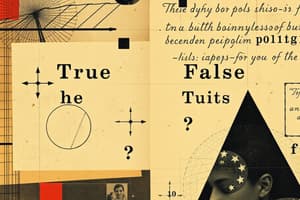Podcast
Questions and Answers
What is factorial notation used for in mathematics?
What is factorial notation used for in mathematics?
- Calculating the product of all positive integers up to a given number (correct)
- Expressing the sum of all positive integers
- Representing arrangements with repetition
- Counting the number of subsets in a collection
How is the number of permutations calculated for arrangements without repetition?
How is the number of permutations calculated for arrangements without repetition?
- $n^n$
- $n^2$
- $n!$ (correct)
- $2n$
What does a circular permutation refer to?
What does a circular permutation refer to?
- A permutation with no repetition
- A permutation with a fixed starting point
- A permutation followed by some number of rotations (correct)
- A permutation followed by some number of divisions
If a set has 6 elements and repetitions are allowed, how many circular permutations are possible?
If a set has 6 elements and repetitions are allowed, how many circular permutations are possible?
Which type of permutation considers repeating elements within a set?
Which type of permutation considers repeating elements within a set?
What is the formula for calculating the number of permutations for arrangements without repetition?
What is the formula for calculating the number of permutations for arrangements without repetition?
In factorial notation, what does $5!$ represent?
In factorial notation, what does $5!$ represent?
What does the term 'cyclic' refer to in the context of permutations?
What does the term 'cyclic' refer to in the context of permutations?
If you have 8 distinct objects and want to find the number of arrangements without repetition, what formula would you use?
If you have 8 distinct objects and want to find the number of arrangements without repetition, what formula would you use?
What is a subset in combinatorics?
What is a subset in combinatorics?
Study Notes
Linear Permutation of Distinguishable Objects
In mathematics, specifically combinatorics, linear permutations refer to the arrangement of distinguishable objects in a specific order. This concept is often applied when considering factors such as factorial notation, arrangements without repetition, arrangements with repetition, and permutations of subsets.
Factorial Notation
Factorial notation, denoted by the symbol !, expresses the product of all positive integers up to a given number. For example, 5! (pronounced "5 factorial") equals 5 × 4 × 3 × 2 × 1, which is equal to 120. This notation is essential when calculating the number of possible linear permutations.
Arrangements Without Repetition
Arrangements without repetition, also known as permutations, are the different ways of arranging a set of objects in a particular order. If n objects are given, then the number of permutations, P(n), can be calculated using the formula P(n) = n!. For example, if we have four distinct objects, there would be 4 × 3 × 2 × 1 = 24 ways of arranging them linearly.
Arrangements With Repetition
Arrangements with repetition, also known as circular permutations, consider repeating elements within a set. In this context, a circular permutation is a permutation followed by some number of rotations. When dealing with repetitions, the term 'cyclic' is sometimes used instead of 'circular'.
Permutations of Subsets
A subset is a collection of elements taken from another collection. If A is a set with m elements, B a subset of A with k elements, and C the complement of B in A, then the number of linear permutations of the sets A, B, and C can be found by multiplying the number of permutations of each set together: P(B) * P(C).
For instance, let's say we have three unique objects, each represented by a different letter. We want to find all possible linear permutations of these objects. Since there are 3! (6) possible linear permutations of these objects, we can simply list them out: ABC, ACAB, ACBA, ACB, BAC, BAAC, BAACB, BCAA, CB, CBA, CA, CA, CA, and CCA.
Studying That Suits You
Use AI to generate personalized quizzes and flashcards to suit your learning preferences.
Description
Explore the concept of linear permutations in combinatorics, where distinguishable objects are arranged in a specific order. Learn about factorial notation, arrangements without repetition, arrangements with repetition, and permutations of subsets through examples and formulas.




